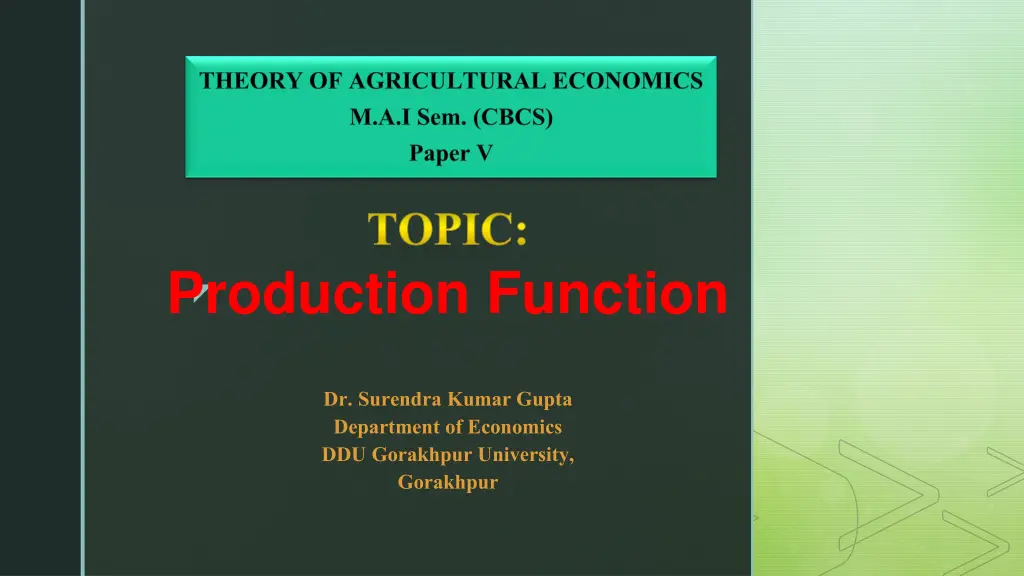
Understanding Production Functions and Their Significance
Explore the meaning of production functions in economics, including short-run and long-run functions, emphasizing the relationship between inputs and outputs. Learn about factors affecting output in various production scenarios.
Download Presentation

Please find below an Image/Link to download the presentation.
The content on the website is provided AS IS for your information and personal use only. It may not be sold, licensed, or shared on other websites without obtaining consent from the author. If you encounter any issues during the download, it is possible that the publisher has removed the file from their server.
You are allowed to download the files provided on this website for personal or commercial use, subject to the condition that they are used lawfully. All files are the property of their respective owners.
The content on the website is provided AS IS for your information and personal use only. It may not be sold, licensed, or shared on other websites without obtaining consent from the author.
E N D
Presentation Transcript
TOPIC: Production Function Dr. Surendra Kumar Gupta Department of Economics DDU Gorakhpur University, Gorakhpur
Meaning of Production Function In simple words, production function refers to the functional relationship between the quantity of a good produced (output) and factors of production (inputs). The production function is purely a technical relation which connects factor inputs and output. Prof. Koutsoyiannis Defined production function as the relation between a firm s physical production (output) and the material factors of production (inputs). Prof. Watson In other words, we can say that production function is an indicator of the physical relationship between the inputs and output of a firm.
Conti. Mathematically, such a basic relationship between inputs and outputs may be expressed as: Q = f( L, C, N ) Where Q = Quantity of output L = Labour K = Capital E = Land. Hence, the level of output (Q), depends on the quantities of different inputs (L, K, E) available to the firm. In the simplest case, where there are only two inputs, labour (L) and capital (K) and one output (Q), the production function becomes. Q =f (L, K) Production function can be divide in short run production function and long run production function .
Meaning of Short-Run Production Function Short-run is a period in which the output can be increased by increasing the input of some variable factor. In the short run, the fixed factor remains constant and variable factors change with change in output. For this, When one factor is a fixed factor and other is variable, then the function can be expressed as: Qx= f(L, K ) Here, Qx= Output of commodity-X L = Labour, a variable factor K = Capital, a fixed factor In this, the output can only be increased by increasing the application of variable factors i.e. labour. Since Capital is constant and only labour changes, the ratio between capital and labour tends to change. This generates the law of variable proportion.
Meaning of Long run Production Function Long Run is a period in which the output can be increased by increasing all the inputs. In the long run, all the factors are variable and change with change in output. For this, When both factors are variable, then the production function can be expressed as: Qx= f(L, K) Here, Qx= Output of commodity-X L = Labour, a variable factor K = Capital, a variable factor In long-run function, the output can be increased by increasing the application of variable factors i.e. labour and capital. Since Capital and labour, both changes, so the production take place at large scale that s why This generates the law of Return to Scale..
Difference between Short Run Production function and long Run Production Function Short-Run Production Function It defines the functional relationship between inputs and output of a commodity for a short period of time. In this, the capital-labour ratio changes with the change in output. The law of returns to a factor is applied for this function. Here, the capital is assumed as the fixed factor and labour as a variable factor. Long-Run Production Function It defines the functional relationship between inputs and output of a commodity for a longer period of time. In this, the capital-labour ratio doesn t change with the change in output. The law of returns to a scale is applied for this function. Here, all the factors of production are variable factors. Basis of Difference Meaning Capital-Labour Ratio Related Law Fixed and Variable Factors
Conclusion Thus, To understand the whole concept of the production function, it is classified into the short-run and long-run. In the shorter period of time, the capital inputs are assumed as fixed and others are variable whereas all the inputs are assumed as the variable for a longer period of time.
